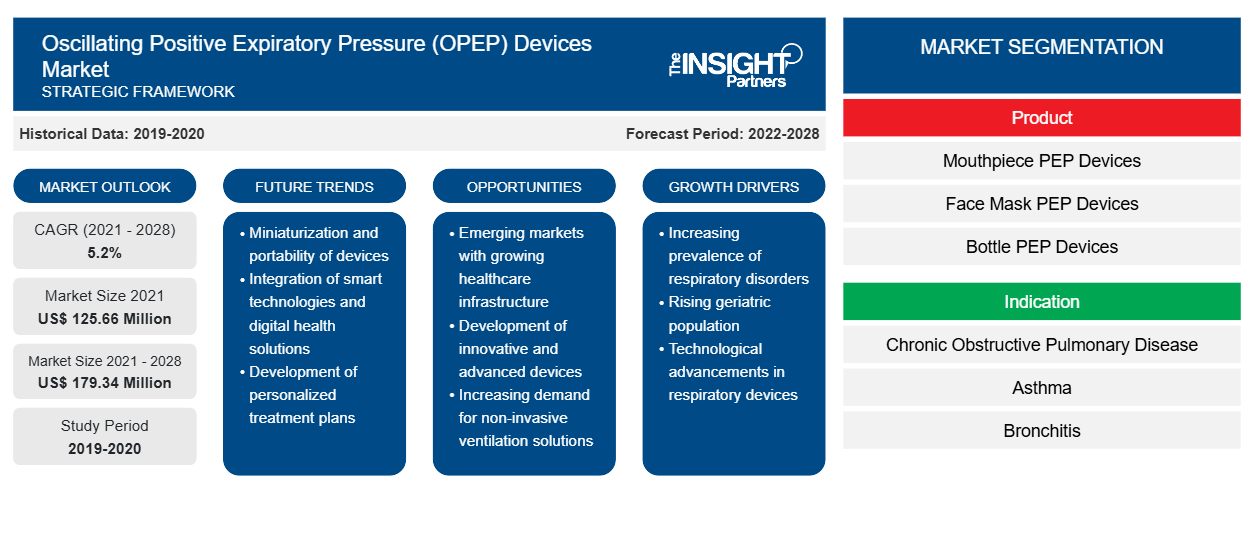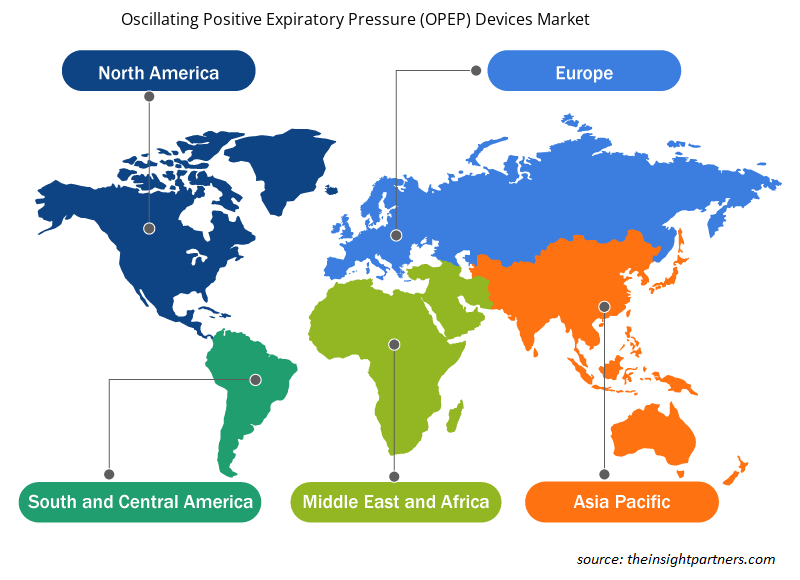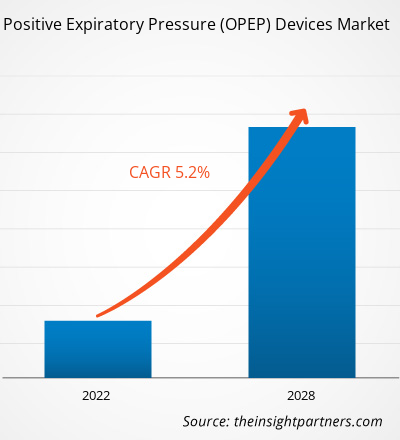Si prevede che il mercato dei dispositivi a pressione espiratoria positiva oscillante (OPEP) crescerà da 125,66 milioni di dollari nel 2021 a 179,34 milioni di dollari entro il 2028; si stima che crescerà a un CAGR del 5,2% nel periodo 2021-2028.
I dispositivi a pressione espiratoria positiva oscillante (OPEP) sono stati utilizzati come supplemento alla tradizionale fisioterapia toracica (CPT) per aiutare a liberare le secrezioni respiratorie nelle persone che non riescono a tossire, in particolare quelle con patologie croniche. L'uso dei dispositivi OPEP è ancora limitato nei disturbi cronici delle vie aeree come fibrosi cistica, bronchiectasie, bronchite, asma bronchiale e sindrome da discinesia ciliare primaria. Nella broncopneumopatia cronica ostruttiva (BPCO), i dispositivi a pressione espiratoria positiva oscillante (OPEP) aiutano a liberare l'espettorato.
La crescita del mercato dei dispositivi a pressione espiratoria positiva oscillante (OPEP) è attribuita alla crescente prevalenza di broncopneumopatia cronica ostruttiva (COPD) e asma, e ai progressi nelle tecnologie mediche. Tuttavia, la scarsa consapevolezza e l'accesso limitato ai dispositivi OPEP ostacolano la crescita del mercato.
Personalizza questo report in base alle tue esigenze
Riceverai la personalizzazione gratuita di qualsiasi report, comprese parti di questo report, o analisi a livello nazionale, pacchetto dati Excel, oltre a usufruire di grandi offerte e sconti per start-up e università
Mercato dei dispositivi a pressione espiratoria positiva oscillante (OPEP): approfondimenti strategici

- Scopri le principali tendenze di mercato in questo rapporto.Questo campione GRATUITO includerà analisi di dati che spaziano dalle tendenze di mercato alle stime e alle previsioni.
Approfondimenti di mercato
La crescente prevalenza della broncopneumopatia cronica ostruttiva (BPCO) e dell'asma stimola la crescita del mercato
L'incidenza di BPCO e fibrosi cistica è in aumento in tutto il mondo. Secondo l'Organizzazione Mondiale della Sanità (OMS), le esacerbazioni della BPCO sono eventi critici. La disabilità e la mortalità correlate alla BPCO spingono la domanda di dispositivi OPEP. Secondo il Center for Disease Control and Prevention (CDC), nel 2018 a circa 9 milioni di adulti è stata diagnosticata la bronchite cronica . Inoltre, l'asma sta diventando comune tra persone di tutte le età, sessi e razze. Secondo il CDC, circa 300 milioni di persone in tutto il mondo soffrono di asma, con un'aggiunta prevista di 100 milioni entro il 2025. La prevalenza, la gravità e la mortalità dell'asma variano notevolmente negli Stati Uniti. L'asma colpisce oltre 25 milioni di persone negli Stati Uniti, il che equivale al 7,7% degli adulti e all'8,4% dei bambini. Secondo il Global Asthma Report del 2018 su Auckland, Nuova Zelanda, l'asma si classifica al 16° posto tra le principali cause di disabilità e al 28° tra le principali fonti di carico di malattia, come valutato in base agli anni di vita aggiustati per disabilità. È comune nei paesi ad alto reddito, mentre la maggior parte dei decessi correlati all'asma si verifica nei paesi a basso e medio reddito. Pertanto, la crescente prevalenza di BPCO e asma spinge la domanda di dispositivi per la pulizia delle mucose, come i dispositivi OPEP, che rafforzano la crescita del mercato dei dispositivi a pressione espiratoria positiva oscillante (OPEP).
Approfondimenti basati sui prodotti
Il mercato dei dispositivi a pressione espiratoria positiva oscillante (OPEP), in base al prodotto, è suddiviso in dispositivi PEP a boccaglio, dispositivi PEP a maschera facciale e dispositivi PEP a flacone. Il segmento dei dispositivi PEP a boccaglio ha detenuto la quota maggiore del mercato nel 2021. Inoltre, si prevede che registrerà un CAGR del 5,3% nel mercato durante il periodo di previsione. Il PEP a boccaglio aiuta a rimuovere il muco dai polmoni. Può anche prevenire il collasso polmonare o aprire aree che sono collassate. Uno dei fattori chiave che guidano il mercato dei dispositivi PEP a boccaglio è la crescente popolazione anziana, unita a tassi più elevati di malattie croniche come la broncopneumopatia cronica ostruttiva (BPCO) e l'asma. Secondo i Centers for Disease Control and Prevention (CDC), entro il 2020 circa 9 milioni di persone riceveranno una diagnosi di bronchite cronica, determinando così la necessità di dispositivi a boccaglio.
Indicazioni approfondite
In base all'indicazione, il mercato dei dispositivi a pressione espiratoria positiva oscillante (OPEP) è segmentato in broncopneumopatia cronica ostruttiva (BPCO), asma, bronchite, bronchiectasie, fibrosi cistica e altri. Il segmento della BPCO ha detenuto la quota maggiore del mercato nel 2021. Tuttavia, si prevede che il segmento dell'asma registrerà un CAGR del 6,0% durante il periodo di previsione. La BPCO è una malattia comune e curabile caratterizzata da progressiva limitazione del flusso d'aria e distruzione dei tessuti. È associata a cambiamenti polmonari strutturali dovuti a infiammazione cronica da esposizione prolungata a particelle o gas nocivi, più comunemente fumo di sigaretta. L'infiammazione cronica provoca il restringimento delle vie aeree e una riduzione del rinculo polmonare.
I lanci e le approvazioni di prodotti sono strategie comunemente adottate dalle aziende per espandere la loro presenza globale e i loro portafogli di prodotti. Inoltre, gli operatori del mercato dei dispositivi a pressione espiratoria positiva oscillante (OPEP) si concentrano sulla strategia di partnership per ampliare la loro clientela, il che, a sua volta, consente loro di mantenere il loro marchio a livello globale. Si prevede che il mercato prospererà nei prossimi anni grazie allo sviluppo di prodotti innovativi da parte degli operatori del mercato.
Dispositivi a pressione espiratoria positiva oscillante
Approfondimenti regionali sul mercato dei dispositivi a pressione espiratoria positiva oscillante (OPEP)
Le tendenze regionali e i fattori che influenzano il mercato dei dispositivi a pressione espiratoria positiva oscillante (OPEP) durante il periodo di previsione sono stati ampiamente spiegati dagli analisti di Insight Partners. Questa sezione discute anche i segmenti di mercato dei dispositivi a pressione espiratoria positiva oscillante (OPEP) e la geografia in Nord America, Europa, Asia Pacifico, Medio Oriente e Africa e Sud e Centro America.

- Ottieni i dati specifici regionali per il mercato dei dispositivi a pressione espiratoria positiva oscillante (OPEP)
Ambito del rapporto di mercato sui dispositivi a pressione espiratoria positiva oscillante (OPEP)
| Attributo del report | Dettagli |
|---|---|
| Dimensioni del mercato nel 2021 | 125,66 milioni di dollari USA |
| Dimensioni del mercato entro il 2028 | 179,34 milioni di dollari USA |
| CAGR globale (2021 - 2028) | 5,2% |
| Dati storici | 2019-2020 |
| Periodo di previsione | 2022-2028 |
| Segmenti coperti | Per Prodotto
|
| Regioni e Paesi coperti | America del Nord
|
| Leader di mercato e profili aziendali chiave |
|
Dispositivi a pressione espiratoria positiva oscillante (OPEP) Densità degli attori del mercato: comprendere il suo impatto sulle dinamiche aziendali
Il mercato dei dispositivi a pressione espiratoria positiva oscillante (OPEP) sta crescendo rapidamente, spinto dalla crescente domanda degli utenti finali dovuta a fattori quali l'evoluzione delle preferenze dei consumatori, i progressi tecnologici e una maggiore consapevolezza dei vantaggi del prodotto. Con l'aumento della domanda, le aziende stanno ampliando le loro offerte, innovando per soddisfare le esigenze dei consumatori e capitalizzando sulle tendenze emergenti, il che alimenta ulteriormente la crescita del mercato.
La densità degli operatori di mercato si riferisce alla distribuzione di aziende o società che operano in un particolare mercato o settore. Indica quanti concorrenti (operatori di mercato) sono presenti in un dato spazio di mercato in relazione alle sue dimensioni o al valore di mercato totale.
Le principali aziende che operano nel mercato dei dispositivi a pressione espiratoria positiva oscillante (OPEP) sono:
- Allergan Plc.
- PARI GmbH
- Farmacia medica Smith
- Fisioterapia
- D
Disclaimer : le aziende elencate sopra non sono classificate secondo un ordine particolare.

- Ottieni la panoramica dei principali attori del mercato dei dispositivi a pressione espiratoria positiva oscillante (OPEP)
Profili aziendali
- Allergan Plc.
- PARI GmbH
- Medico di Smith
- Fisioterapia
- ASSISTENZA SANITARIA D•R BURTON
- Società di gestione Medica, LLC
- CEGLA Medizintechnik GmbH & Co. KG
- Assistenza sanitaria abile
- Trudell Medico Internazionale
- Mercurio medico
- Analisi storica (2 anni), anno base, previsione (7 anni) con CAGR
- Analisi PEST e SWOT
- Valore/volume delle dimensioni del mercato - Globale, Regionale, Nazionale
- Industria e panorama competitivo
- Set di dati Excel
Report recenti
Testimonianze
Motivo dell'acquisto
- Processo decisionale informato
- Comprensione delle dinamiche di mercato
- Analisi competitiva
- Analisi dei clienti
- Previsioni di mercato
- Mitigazione del rischio
- Pianificazione strategica
- Giustificazione degli investimenti
- Identificazione dei mercati emergenti
- Miglioramento delle strategie di marketing
- Aumento dell'efficienza operativa
- Allineamento alle tendenze normative




















 Ottieni un campione gratuito per - Mercato dei dispositivi a pressione espiratoria positiva oscillante (OPEP)
Ottieni un campione gratuito per - Mercato dei dispositivi a pressione espiratoria positiva oscillante (OPEP)